24 july 2018
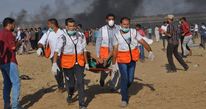
Three Palestinian citizens were injured Tuesday evening by an airstrike carried out by an Israeli drone east of Gaza.
The PIC reporter said that an Israeli drone fired one missile at a group of Palestinian citizens east of Shuja'ia neighborhood in Gaza injuring three of them.
Earlier, a Palestinian youth was injured when Israeli soldiers stationed at the border fence east of Jabalia, in the northern Gaza Strip, opened fire at Palestinian protesters.
According to the PIC reporter, a Palestinian child was injured after being hit with a teargas canister fired by Israeli occupation forces east of al-Bureij camp in the central Gaza Strip.
Two other Palestinians were injured Tuesday morning in Israeli attacks on two separate groups east of Jabalia. Safa news agency reported that a Palestinian youth was injured by Israeli gunfire near the border, while another sustained a minor injury in a drone attack.
These Israeli attacks blatantly violate the Egypt-brokered ceasefire agreement reached between Israel and the Palestinian resistance factions on Friday evening.
The PIC reporter said that an Israeli drone fired one missile at a group of Palestinian citizens east of Shuja'ia neighborhood in Gaza injuring three of them.
Earlier, a Palestinian youth was injured when Israeli soldiers stationed at the border fence east of Jabalia, in the northern Gaza Strip, opened fire at Palestinian protesters.
According to the PIC reporter, a Palestinian child was injured after being hit with a teargas canister fired by Israeli occupation forces east of al-Bureij camp in the central Gaza Strip.
Two other Palestinians were injured Tuesday morning in Israeli attacks on two separate groups east of Jabalia. Safa news agency reported that a Palestinian youth was injured by Israeli gunfire near the border, while another sustained a minor injury in a drone attack.
These Israeli attacks blatantly violate the Egypt-brokered ceasefire agreement reached between Israel and the Palestinian resistance factions on Friday evening.

Majd Abu al-Eish ‘Oqeil 26
A Palestinian youth succumbed to his wounds on Tuesday that he had sustained two months ago during "The Great March of Return" protests along the eastern borders of the besieged Gaza Strip.
According to the Ministry of Health in Gaza, the Palestinian youth was identified as Majd Abu al-Eish from the northern village of Jabaliya in Gaza.
The ministry confirmed that he succumbed to his wounds sustained on June 15th during protests in Gaza.
Meanwhile, a Ma'an reporter said that Israeli forces fired live ammunition at a group of Palestinian youths injuring one east of Gaza City, on Tuesday.
Sources confirmed the youth suffers from moderate injuries; his identity remains unknown.
A Palestinian youth succumbed to his wounds on Tuesday that he had sustained two months ago during "The Great March of Return" protests along the eastern borders of the besieged Gaza Strip.
According to the Ministry of Health in Gaza, the Palestinian youth was identified as Majd Abu al-Eish from the northern village of Jabaliya in Gaza.
The ministry confirmed that he succumbed to his wounds sustained on June 15th during protests in Gaza.
Meanwhile, a Ma'an reporter said that Israeli forces fired live ammunition at a group of Palestinian youths injuring one east of Gaza City, on Tuesday.
Sources confirmed the youth suffers from moderate injuries; his identity remains unknown.

An unmanned Israeli drones on Tuesday attacked a group of Palestinian civilians gathering near the border fence separating the blockaded Gaza Strip from territories occupied in 1948.
An Israeli drone fired a missile toward a group of Palestinians east of Jabalia town, to the north of the Gaza Strip.
No injuries were reported in the offensive.
The targeted youths were reportedly making up incendiary kites to respond to such aggressions by the Israeli military on the besieged coastal enclave which have gone unabated over recent weeks.
An Israeli drone fired a missile toward a group of Palestinians east of Jabalia town, to the north of the Gaza Strip.
No injuries were reported in the offensive.
The targeted youths were reportedly making up incendiary kites to respond to such aggressions by the Israeli military on the besieged coastal enclave which have gone unabated over recent weeks.
23 july 2018

An Israeli drone on Monday evening attacked a group of Palestinian citizens east of Jabalia in the northern Gaza Strip.
The PIC reporter said that the Israeli drone fired at least one missile at a group of Palestinian youths with no casualties reported.
Two Palestinians were injured Sunday in a similar attack. The Israeli occupation army claimed that the attacks targeted Palestinians trying to fly fire kites and balloons toward Israeli settlements neighboring the Gaza Strip.
In a related context, a local source reported that Israeli tanks stationed at the border fence east of Deir al-Balah city, in the central Gaza Strip, opened fire at farmlands and a resistance post near the border. No injuries were reported.
These Israeli attacks blatantly violate the Egypt-brokered ceasefire agreement reached Friday evening between Israel and the Palestinian resistance factions.
The PIC reporter said that the Israeli drone fired at least one missile at a group of Palestinian youths with no casualties reported.
Two Palestinians were injured Sunday in a similar attack. The Israeli occupation army claimed that the attacks targeted Palestinians trying to fly fire kites and balloons toward Israeli settlements neighboring the Gaza Strip.
In a related context, a local source reported that Israeli tanks stationed at the border fence east of Deir al-Balah city, in the central Gaza Strip, opened fire at farmlands and a resistance post near the border. No injuries were reported.
These Israeli attacks blatantly violate the Egypt-brokered ceasefire agreement reached Friday evening between Israel and the Palestinian resistance factions.
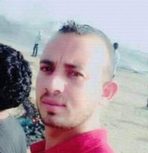
Karam Ibrahim Arafat, 26
The Palestinian Health Ministry in Gaza has reported, on Monday at dawn, that a young man died from serious wounds he suffered, on June 8th, after Israeli soldiers shot him with live fire.
The Ministry said the young man, identified as Karam Ibrahim Arafat, 26, was shot during the “Great Return March” procession, east of Khan Younis, in the southern part of the Gaza Strip.
It added that Arafat, from Abasan al-Saghira town, southeast of Khan Younis, was shot with a live round in the head, and remained in a critical condition until he succumbed to his serious wounds.
Also at dawn, dozens of soldiers invaded the Deheishe refugee camp, south of the West Bank city of Bethlehem, killed one child, identified as Akram Tha’er Mizhir, 15, injured two young men and caused dozens to suffer the effects of teargas inhalation.
On July 20th, the army killed four Palestinians, identified as Mohammad Sharif Badwan, 27, Mohammad Abu Farhana, 31, Mahmoud Khalil Qishta, 23, Sha’ban Rajab Abu Khater, 26.
On the same day, Palestinian fighters in Gaza killed one soldier, identified as Aviv Levi, 20, from Petah Tikva, in the Central District.
The soldier is the first to be killed by Palestinian fire since Israel’s offensive and major deadly assault in Gaza in 2014.
Israeli Walla News said an Israeli army investigation revealed that the soldier was shot by a Palestinian sniper, hundreds of meters away, and added that Levi was kneeling in a sniper post when he was shot in the upper body.
It stated that Israeli army officials believe that the sniper fire was not approved by Hamas leadership, but was likely ordered by the shooter’s “direct commander.”
The report quoted defense officials stating that Hamas’s armed wing leadership would not place their political leader Ismael Haniyya in danger of Israeli fire, especially since he was present near the protest area, close to the border fence, when the soldier was shot.
The officials said it possible that one fighter decided to shoot a soldier in retaliation for the death of another fighter, who was killed by army fire Thursday.
Karam’s death brings the number of Palestinians, killed by Israeli army fire in Gaza since the beginning of the Great Return March protests on March 30th, to 147, including 17 children, two medics and two journalists.
The Palestinian Health Ministry in Gaza has reported, on Monday at dawn, that a young man died from serious wounds he suffered, on June 8th, after Israeli soldiers shot him with live fire.
The Ministry said the young man, identified as Karam Ibrahim Arafat, 26, was shot during the “Great Return March” procession, east of Khan Younis, in the southern part of the Gaza Strip.
It added that Arafat, from Abasan al-Saghira town, southeast of Khan Younis, was shot with a live round in the head, and remained in a critical condition until he succumbed to his serious wounds.
Also at dawn, dozens of soldiers invaded the Deheishe refugee camp, south of the West Bank city of Bethlehem, killed one child, identified as Akram Tha’er Mizhir, 15, injured two young men and caused dozens to suffer the effects of teargas inhalation.
On July 20th, the army killed four Palestinians, identified as Mohammad Sharif Badwan, 27, Mohammad Abu Farhana, 31, Mahmoud Khalil Qishta, 23, Sha’ban Rajab Abu Khater, 26.
On the same day, Palestinian fighters in Gaza killed one soldier, identified as Aviv Levi, 20, from Petah Tikva, in the Central District.
The soldier is the first to be killed by Palestinian fire since Israel’s offensive and major deadly assault in Gaza in 2014.
Israeli Walla News said an Israeli army investigation revealed that the soldier was shot by a Palestinian sniper, hundreds of meters away, and added that Levi was kneeling in a sniper post when he was shot in the upper body.
It stated that Israeli army officials believe that the sniper fire was not approved by Hamas leadership, but was likely ordered by the shooter’s “direct commander.”
The report quoted defense officials stating that Hamas’s armed wing leadership would not place their political leader Ismael Haniyya in danger of Israeli fire, especially since he was present near the protest area, close to the border fence, when the soldier was shot.
The officials said it possible that one fighter decided to shoot a soldier in retaliation for the death of another fighter, who was killed by army fire Thursday.
Karam’s death brings the number of Palestinians, killed by Israeli army fire in Gaza since the beginning of the Great Return March protests on March 30th, to 147, including 17 children, two medics and two journalists.
22 july 2018
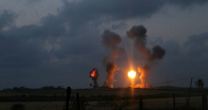
Two Palestinians were injured Sunday evening by an Israeli airstrike that targeted a group of Palestinian citizens east of Jabalia in the northern Gaza Strip.
The PIC reporter said that an Israeli drone fired at least one missile at a group of Palestinian youths near the Great March of Return camps east of Jabalia.
Gaza 's Ministry of Health said that two Palestinian youths were injured in the attack and described their injuries as "moderate to minor".
A spokesman for the Israeli occupation army claimed that the drone targeted a group of Palestinians who were flying fire kites and balloons toward Israeli settlements neighboring the Gaza Strip.
The Israeli attack violates the Egypt-brokered ceasefire reached between Israel and the Palestinian resistance factions on Friday evening.
Meanwhile, a Palestinian youth was injured after being shot by the Israeli occupation forces stationed at the border fence east of al-Bureij refugee camp in the central Gaza Strip.
The PIC reporter said that the youth was moderately injured after Israeli soldiers opened fire at Palestinian civilians peacefully taking part in the Great March of Return.
The PIC reporter said that an Israeli drone fired at least one missile at a group of Palestinian youths near the Great March of Return camps east of Jabalia.
Gaza 's Ministry of Health said that two Palestinian youths were injured in the attack and described their injuries as "moderate to minor".
A spokesman for the Israeli occupation army claimed that the drone targeted a group of Palestinians who were flying fire kites and balloons toward Israeli settlements neighboring the Gaza Strip.
The Israeli attack violates the Egypt-brokered ceasefire reached between Israel and the Palestinian resistance factions on Friday evening.
Meanwhile, a Palestinian youth was injured after being shot by the Israeli occupation forces stationed at the border fence east of al-Bureij refugee camp in the central Gaza Strip.
The PIC reporter said that the youth was moderately injured after Israeli soldiers opened fire at Palestinian civilians peacefully taking part in the Great March of Return.
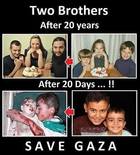
Gaza's Great March of Return movement, which began more than three months ago, represents a shift in the Palestinian national struggle - especially in the besieged coastal territory.
After the 2014 Gaza war, Israel's right-wing government believed that it had successfully quashed resistance to its methods. The devastation wrought on Gaza in 2014 - including thousands of deaths and injuries, along with severe infrastructural damage - compounded pre-existing problems stemming from Israel’s assaults in 2008 and 2012.
Making matters worse, the ongoing siege of Gaza prevents the entry of many goods and restricts the movement of those goods, as well as individuals. This has hindered production and development operations in Gaza, relegating it to a captive consumer market in which most residents rely on UN assistance.
Stalled reconstruction
The Great March of Return movement highlights the refusal of Palestinians to cower in submission, despite the Netanyahu government’s best efforts.
Israel has taken many steps to try to secure that submission, including hampering the reconstruction process by preventing the import of construction materials.
The crisis in Gaza is manifested in the unprecedented rise in poverty and unemployment rates. Nearly half of the population is jobless, while the territory’s poverty rate has reached 80 percent. Thousands of students graduate from Palestinian universities in Gaza each year, but amid the ongoing humanitarian catastrophe and a severely weakened private sector, there are no jobs for them.
Gaza is also grappling with the repercussions of the internal divide between Hamas and the Ramallah-based Palestinian Authority, in addition to water pollution, inadequate medical facilities and power that is often unavailable for more than a few hours a day. In effect, Gaza has been transformed into a large "open air prison" that the UN says will be uninhabitable within the next couple of years.
The Great March of Return has fostered unity in the face of such challenges, bringing together political and social forces from across the spectrum. It has also increased international solidarity and added momentum to the Boycott, Divestment and Sanctions (BDS) movement, placing the Palestinian cause at the forefront of the world’s attention - after being sidelined for too long amid broader regional unrest.
Killed in cold blood
Gaza’s protest movement has highlighted, for all the world to see, the brutality of the occupying force. Children, women, elderly residents, paramedics, journalists: everyone is a potential target. Many demonstrators have been killed or injured in recent weeks, underscoring Israel’s ongoing human rights violations.
At the same time, the occupation government has attempted to discredit peaceful protesters, some of whom have sent fiery kites across the fence separating Gaza from Israel. Israel has tried to present the kites, which have damaged some fields, as violent military combat tools meriting a crushing, retaliatory air assault.
Israel's extreme response to the Great March of Return has hardened that movement's will. Resistance has spread to various areas of the West Bank and the diaspora, highlighting the power of the Palestinian national will in the face of occupation-driven displacement and geographic fragmentation.
Meanwhile, Israel has been trying to ramp up the economic pressure on Gaza, closing the Karam Abu Salem border crossing, the only commercial portal into Gaza.
This military and economic pressure coincides with regional and international moves ostensibly aimed at easing tensions and preventing the outbreak of a new war in the Gaza Strip. At a recent news conference in Gaza, Nickolay Mladenov, the UN envoy for the Middle East peace process, announced a plan to improve the economy and alleviate residents’ suffering.
Qatar has also been working to broker a truce in Gaza, including the possibility of a prisoner exchange, while the United States continues to promote its “deal of the century”.
Collective punishment
However, many observers believe that such measures address the outcome rather than the cause. The reason for the economic deterioration in Gaza lies in the Israel's siege and occupation. The international community must put pressure on the occupying state to end the siege, which constitutes collective punishment.
Humanitarian projects may lead to temporary improvements in Gaza, but without a broader solution to end the siege, the benefits quickly vanish. Real development requires the free movement of goods and people within an independent sovereign state that enjoys the right to self-determination. Anything else is a sop.
Israel has imposed on Gaza an atmosphere of war; the threat of a new attack looms every day. Air strikes on sites in Gaza, launched under the pretext of retaliation for the Palestinian kites, aim to end the protest movement without ever addressing the Palestinian demands for their right of return or a lifting of the siege. Israel wants Palestinians to prioritise social and economic issues over national and legal ones, but these things are entwined.
Israel's mentality of hegemony and arrogance is reflected in its will to impose a lasting siege and commit perpetual violations of Palestinian rights. The international community must pressure Israel to end this siege, instead of looking for partial economic fixes that enable Gaza struggle on as a giant prison.
- Mohsen Abu Ramadan is the former director of the Palestinian Non-Governmental Organisation Network (PNGO).
After the 2014 Gaza war, Israel's right-wing government believed that it had successfully quashed resistance to its methods. The devastation wrought on Gaza in 2014 - including thousands of deaths and injuries, along with severe infrastructural damage - compounded pre-existing problems stemming from Israel’s assaults in 2008 and 2012.
Making matters worse, the ongoing siege of Gaza prevents the entry of many goods and restricts the movement of those goods, as well as individuals. This has hindered production and development operations in Gaza, relegating it to a captive consumer market in which most residents rely on UN assistance.
Stalled reconstruction
The Great March of Return movement highlights the refusal of Palestinians to cower in submission, despite the Netanyahu government’s best efforts.
Israel has taken many steps to try to secure that submission, including hampering the reconstruction process by preventing the import of construction materials.
The crisis in Gaza is manifested in the unprecedented rise in poverty and unemployment rates. Nearly half of the population is jobless, while the territory’s poverty rate has reached 80 percent. Thousands of students graduate from Palestinian universities in Gaza each year, but amid the ongoing humanitarian catastrophe and a severely weakened private sector, there are no jobs for them.
Gaza is also grappling with the repercussions of the internal divide between Hamas and the Ramallah-based Palestinian Authority, in addition to water pollution, inadequate medical facilities and power that is often unavailable for more than a few hours a day. In effect, Gaza has been transformed into a large "open air prison" that the UN says will be uninhabitable within the next couple of years.
The Great March of Return has fostered unity in the face of such challenges, bringing together political and social forces from across the spectrum. It has also increased international solidarity and added momentum to the Boycott, Divestment and Sanctions (BDS) movement, placing the Palestinian cause at the forefront of the world’s attention - after being sidelined for too long amid broader regional unrest.
Killed in cold blood
Gaza’s protest movement has highlighted, for all the world to see, the brutality of the occupying force. Children, women, elderly residents, paramedics, journalists: everyone is a potential target. Many demonstrators have been killed or injured in recent weeks, underscoring Israel’s ongoing human rights violations.
At the same time, the occupation government has attempted to discredit peaceful protesters, some of whom have sent fiery kites across the fence separating Gaza from Israel. Israel has tried to present the kites, which have damaged some fields, as violent military combat tools meriting a crushing, retaliatory air assault.
Israel's extreme response to the Great March of Return has hardened that movement's will. Resistance has spread to various areas of the West Bank and the diaspora, highlighting the power of the Palestinian national will in the face of occupation-driven displacement and geographic fragmentation.
Meanwhile, Israel has been trying to ramp up the economic pressure on Gaza, closing the Karam Abu Salem border crossing, the only commercial portal into Gaza.
This military and economic pressure coincides with regional and international moves ostensibly aimed at easing tensions and preventing the outbreak of a new war in the Gaza Strip. At a recent news conference in Gaza, Nickolay Mladenov, the UN envoy for the Middle East peace process, announced a plan to improve the economy and alleviate residents’ suffering.
Qatar has also been working to broker a truce in Gaza, including the possibility of a prisoner exchange, while the United States continues to promote its “deal of the century”.
Collective punishment
However, many observers believe that such measures address the outcome rather than the cause. The reason for the economic deterioration in Gaza lies in the Israel's siege and occupation. The international community must put pressure on the occupying state to end the siege, which constitutes collective punishment.
Humanitarian projects may lead to temporary improvements in Gaza, but without a broader solution to end the siege, the benefits quickly vanish. Real development requires the free movement of goods and people within an independent sovereign state that enjoys the right to self-determination. Anything else is a sop.
Israel has imposed on Gaza an atmosphere of war; the threat of a new attack looms every day. Air strikes on sites in Gaza, launched under the pretext of retaliation for the Palestinian kites, aim to end the protest movement without ever addressing the Palestinian demands for their right of return or a lifting of the siege. Israel wants Palestinians to prioritise social and economic issues over national and legal ones, but these things are entwined.
Israel's mentality of hegemony and arrogance is reflected in its will to impose a lasting siege and commit perpetual violations of Palestinian rights. The international community must pressure Israel to end this siege, instead of looking for partial economic fixes that enable Gaza struggle on as a giant prison.
- Mohsen Abu Ramadan is the former director of the Palestinian Non-Governmental Organisation Network (PNGO).
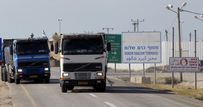
The Israeli military will recommend that the government take measures to make life easier for Gazans and give a chance to understandings reached between Egypt and Hamas over the weekend, Haaretz has reported.
Late Sunday, Israel is expected to announce the easing of the flow of goods through the Karem Abu Salem crossing and the extension of the fishing zone off the Gaza Strip that was curbed following recent events.
Broad discussions are slated to be held at the UN Security Council this week to assess the situation in the blockaded Gaza Strip.
The Israeli military claimed the current round of aggressions has just been brought to a close in anticipation of possible developments.
Late Sunday, Israel is expected to announce the easing of the flow of goods through the Karem Abu Salem crossing and the extension of the fishing zone off the Gaza Strip that was curbed following recent events.
Broad discussions are slated to be held at the UN Security Council this week to assess the situation in the blockaded Gaza Strip.
The Israeli military claimed the current round of aggressions has just been brought to a close in anticipation of possible developments.
21 july 2018
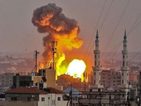
An indirect ceasefire understanding was reached between Hamas and Israel, on Friday at night, following extensive Israeli strikes on the Gaza Strip, and the killing of four Palestinian fighters, and one soldier.
Hamas spokesperson in Gaza, Fawzi Barhoum, said that “through Egyptian, and international mediation, a ceasefire understanding was reached between the occupation and the resistance.”
Israeli sources said the United Nations Envoy to the Middle East, Nickolay Mladenov, held extensive talks with both Israel and Hamas, and added that the ceasefire was reached “because both parties are not interested in escalation.”
He stated that the ceasefire was reached without an agreement, but with the sole purpose of “returning to the era of calm.”
Hamas was pressured by Egypt, Qatar and Turkey to refrain from responding to the Israeli strikes, in order to avoid a serious and extended military escalation.
The understanding was reached after Israel shelled and bombarded more than 68 areas in the Gaza Strip, after following the death of one soldier by Palestinian fire, and four Palestinians by Israeli army fire.
Despite the understanding for ceasefire, Israeli Defense Minister Avigdor Lieberman told Mladenov in a phone call that “the responsibility for escalation or calm lies with Hamas,” and added that “if the group continues to fire shells into Israel, then the outcome will be far worse than what they think.”
Lieberman also said that “the destruction and loss of live will be on Hamas,” Israeli daily Haaretz said.
It is worth mentioning that the slain Israeli soldier, who remained unidentified at the time of this report, is the first Israeli to be killed by the Palestinians in Gaza, since the Great Return March procession started on Palestinian Land Day, March 30th, 2018.
Meanwhile, the Israeli army killed 146 Palestinians protesters, including 17 children, two medics and two journalists, and wounded more than 16496 others.
Israeli army fire also caused damage to 58 Palestinian ambulances in several parts of the Gaza Strip.
On Thursday, July 19, 2018, an Israeli army drone dropped a missile at Palestinians, east of Rafah, in the southern part of the Gaza Strip, killing one Palestinian, identified as Abdul-Karim Radwan, 22, and wounding three others, one seriously.
Hamas spokesperson in Gaza, Fawzi Barhoum, said that “through Egyptian, and international mediation, a ceasefire understanding was reached between the occupation and the resistance.”
Israeli sources said the United Nations Envoy to the Middle East, Nickolay Mladenov, held extensive talks with both Israel and Hamas, and added that the ceasefire was reached “because both parties are not interested in escalation.”
He stated that the ceasefire was reached without an agreement, but with the sole purpose of “returning to the era of calm.”
Hamas was pressured by Egypt, Qatar and Turkey to refrain from responding to the Israeli strikes, in order to avoid a serious and extended military escalation.
The understanding was reached after Israel shelled and bombarded more than 68 areas in the Gaza Strip, after following the death of one soldier by Palestinian fire, and four Palestinians by Israeli army fire.
Despite the understanding for ceasefire, Israeli Defense Minister Avigdor Lieberman told Mladenov in a phone call that “the responsibility for escalation or calm lies with Hamas,” and added that “if the group continues to fire shells into Israel, then the outcome will be far worse than what they think.”
Lieberman also said that “the destruction and loss of live will be on Hamas,” Israeli daily Haaretz said.
It is worth mentioning that the slain Israeli soldier, who remained unidentified at the time of this report, is the first Israeli to be killed by the Palestinians in Gaza, since the Great Return March procession started on Palestinian Land Day, March 30th, 2018.
Meanwhile, the Israeli army killed 146 Palestinians protesters, including 17 children, two medics and two journalists, and wounded more than 16496 others.
Israeli army fire also caused damage to 58 Palestinian ambulances in several parts of the Gaza Strip.
On Thursday, July 19, 2018, an Israeli army drone dropped a missile at Palestinians, east of Rafah, in the southern part of the Gaza Strip, killing one Palestinian, identified as Abdul-Karim Radwan, 22, and wounding three others, one seriously.
Page: 39 - 38 - 37 - 36 - 35 - 34 - 33 - 32 - 31 - 30 - 29 - 28 - 27 - 26 - 25 - 24 - 23 - 22 - 21 - 20 - 19 - 18 - 17 - 16
